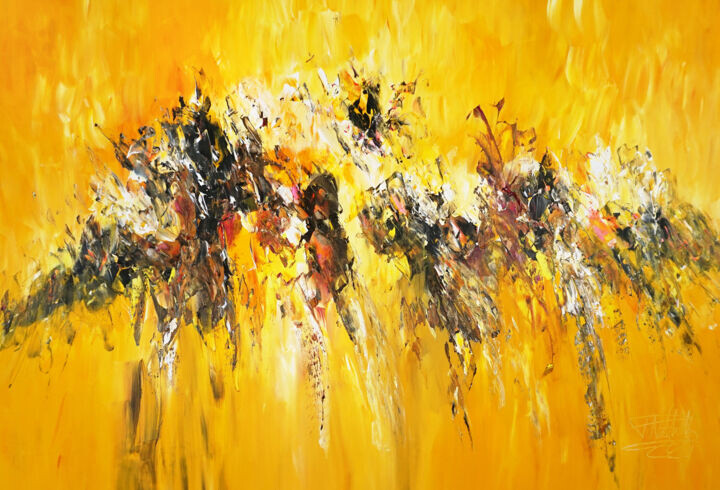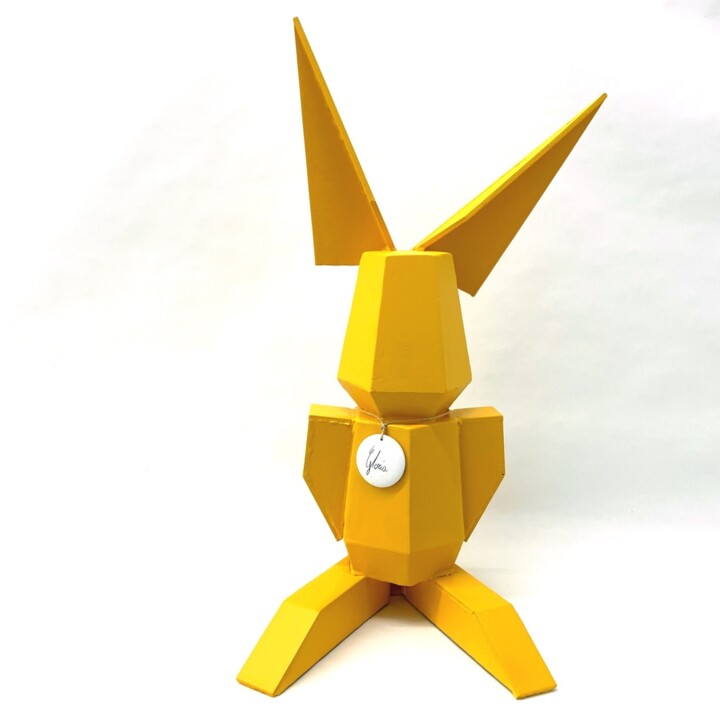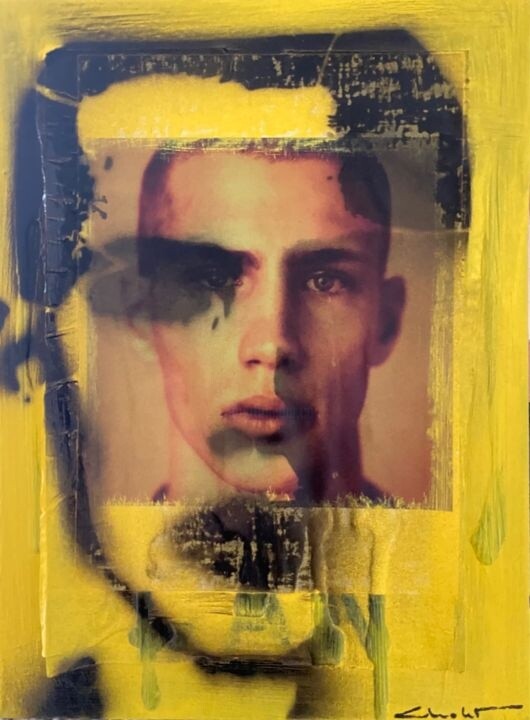 Peter Nottrott, Yellow Symphony XL 1, 2021. Acrylic on canvas, 105 x 155 cm.
Peter Nottrott, Yellow Symphony XL 1, 2021. Acrylic on canvas, 105 x 155 cm.
The multiple, and contrasting, meanings of the color yellow
The color yellow "possesses a gently stimulating quality of serenity and gaiety. It shows itself extremely sensitive, however, producing an unpleasant image when dirty.... A slight and imperceptible movement is enough to make it the color of infamy, revulsion and discomfort..."
The words of Johann Wolfgang von Goethe, one of the greatest writers, thinkers and intellectuals of all time, author of the work Theory of Color, in which yellow becomes the only primary color along with blue, are perfect to introduce a purely "chromo-therapeutic" view of the said shade. In fact, according to this modern alternative medicine, yellow, the color of the sun and gold, helps to regain vitality and energy, so much so that, since ancient Egypt, it was associated with the Sun God, who represented strength and vitality. Going into specifics, in color therapy yellow is considered to be a color that has very strong effects on the psyche, as it can stimulate the intellectual part of the brain and help concentration. In addition, it also represents the desire for change that instills positivity, joy and protection. It is precisely because of these characteristics that yellow is used in supportive therapies to combat depression and apathy, as well as discomforts of a psychosomatic nature. Returning to Goethe's words, however, there is also a "dark side" to the aforementioned hue, which, oftentimes, has been associated with cowardice, illness and mental infirmity. Despite these latter aspects, however, the predominant view of this color remains indelibly linked to the feeling of warmth, brightness and, consequently, positivity.
 Norris Yim, Nameless 2722, 2022. Acrylic on canvas, 70 x 60 cm.
Norris Yim, Nameless 2722, 2022. Acrylic on canvas, 70 x 60 cm.
 Mona Hoel, The talk - morning, 2021. Tempera on wood, 50 x 50 cm.
Mona Hoel, The talk - morning, 2021. Tempera on wood, 50 x 50 cm.
Yellow in the history of art
Because it was widely available and easy to mix, yellow ochre pigment, in all its most diverse shades, was one of the first colors used in art. In fact, it appeared, both in prehistoric, Egyptian and Roman civilizations, where it was used for the creation of paintings rich in a wide range of yellowish gradations, obtained precisely due to the greater or lesser presence of this ferric oxide pigment. However, for the creation of yellow, the Egyptians and Romans also made use of orpimentum, or arsenic sulfide crystal, from which a pure and brilliant yellow was obtained, superior in consistency and intensity to any ochre. Examples of the use of such a mineral are found in the frescoes of Pompeii and in Tutankhamun's tomb, where a small color box with orpiment pigment was recovered. Speaking of medieval times, on the other hand, the color yellow was often used for the making of the light of God as a substitute for gold, which was definitely much more expensive. At the same time, however, this hue began to be denigrated, as it was used to denote outcasts, namely prostitutes, lepers, Jews, and vagrants. Yellow was rehabilitated only in the 19th century, thanks to the research of the Romantics and Impressionists, who focused on capturing the changes in sunlight illumination and the influence of the atmosphere on the visual perception of the landscape. Examples of the above are the works of William Turner, who was in love with Indian yellow, and Vincent van Gogh, who was literally obsessed with chrome yellow. As for the hue beloved by the English master, Indian yellow, from Asia, was discovered by European illustrators only at the end of the seventeenth century, a time when it registered a huge success, since, being very bright and vivid, it was perfect for recreating the sun's rays shaded in the air. Indian yellow, however, had one major flaw: it stank to high heaven. This was because it was produced from the urine of cows fed exclusively on water and mango leaves, which, due to the imbalances engendered by that diet, produced extraordinarily forlorn and colorful urinations. The latter were carefully collected by the herders and, subsequently, boiled and filtered, and then mixed with a little powder in order to give them compactness. The end of the proceedings, on the other hand, was to create small balls of "urine," which were then dried in an oven, resulting in the balls of Indian yellow. As far as Vincent van Gogh is concerned, on the other hand, The Chrome Yellow, based on lead chromate, can be considered a kind of pictorial signature of many of the Dutch master's works, including the famous Sunflowers. It is worth highlighting how, according to some popular rumors, Van Gogh was so crazy about this chromium that he went so far as to eat the color directly from the tubes of paint, in the belief that the latter would bring happiness within him. In addition, few people know that Van Gogh was affected by xanthopsy, which is a particular distortion of perception that made him see the world around him more yellow than normal. In conclusion, despite the Dutch master's mad love for the aforementioned color, he was not the only one who appreciated such a hue, so much so that there are many masterpieces "in yellow" in the history of art, such as, for example: The Hunter by Miró, Impression III by Kandinsky, Joy of Life by Matisse and Gauguin's The Yellow Christ.
 Sabina D'Antonio, Summer sun, 2020. Acrylic / stencil / collage / fabric on canvas, 100 x 100 cm.
Sabina D'Antonio, Summer sun, 2020. Acrylic / stencil / collage / fabric on canvas, 100 x 100 cm.
 Gustaf Tidholm, Lemos lines, 2022. Acrylic on canvas, 60 x 60 cm.
Gustaf Tidholm, Lemos lines, 2022. Acrylic on canvas, 60 x 60 cm.
Works "in yellow" by Artmajeur artists
The love for yellow continues in contemporary art, traversing multiple styles, techniques and color shades, aimed at pursuing the same intent of enlivening, with the warmth, brilliance and positivity of the aforementioned color, the spirits of the users and the artists themselves. In fact, just a work in yellow is enough to bring optimism to any environment, fostering the development of feelings of joy, liveliness, extroversion, lightness, alertness, concentration and openness to growth and change. Such feelings are well expressed by the works of Artmajuer artists and, in particular, those of Gloria Ballestrin, Iris White and Jerome Cholet.
 Gloria Ballestrin, Codo yellow, 2020. Sculpture, Wood on wood, 47 x 22 cm.
Gloria Ballestrin, Codo yellow, 2020. Sculpture, Wood on wood, 47 x 22 cm.
Gloria Ballestrin: Codo yellow
Animal sculptures, made in the many shades of yellow, have now become a "must" in the "Pop" world of contemporary art, just as evidenced by the imposing gorilla installed in Murray Hill (New York) by French-Tunisian artist Idriss B. The animal, the most flamboyant of all, joins a series of equally showy works, which, placed between 34th and 38th streets, will remain on display until February 2023. This cute polygonal gorilla can be compared to Gloria Ballestrin's rabbit, which, made of yellow wood, reproduces, in a very synthetic way, the thousand "facets" of the sculptural surface of Idriss B's work. In spite of this simplification, the Artmajeur artist has created a work full of meaning, since, as stated by himself, it aims to show the "edgy" character of the rabbit, overcoming the stereotype that such an animal is only soft and cute.
 Iris White, Yellow 3D wall, 2022. Acrylic on canvas, 50 x 50 cm.
Iris White, Yellow 3D wall, 2022. Acrylic on canvas, 50 x 50 cm.
Iris White: Yellow 3d wall
A masterpiece of informal art, or that type of abstraction that first appeared in the 1940s in Europe, which renounces any form and consists only of signs and colors freely arranged on the canvas, is Concetto spaziale, Attese, a painting made in yellow by the iconic Italian master Lucio Fontana. This work, part of the artist's most famous series, namely Concetti spaziali (Spatial Concepts), was created through the simple and violent gesture of breaking through the canvas, pursuing the purpose of pushing the boundaries of the pictorial field, questioning its two-dimensionality. Also yellow in color, but with a totally opposite purpose, is the painting by Artmajeur artist Yellow 3d wall, in which other dimensions are sought by bringing in pictorial material, which, conspicuously in relief on the support, contrasts vividly with the aforementioned concept of destroying, and thus removing, parts of the canvas.
 Jerome Cholet, Augusta graffiti yellow, 2020. Collage / acrylic / spray paint on canvas, 40 x 30 cm.
Jerome Cholet, Augusta graffiti yellow, 2020. Collage / acrylic / spray paint on canvas, 40 x 30 cm.
Jerome Cholet: Augusta graffiti yellow
Certainly, among the most iconic "yellow" self-portraits in art history is František Kupka's, which, dating back to 1907, is titled The Yellow Scale. This masterpiece, preserved at the Museum of Fine Arts in Houston, Texas, immortalizes the artist at the age of thirty-six, elegantly seated in a rocking chair, intent on smoking and, probably, pondering a half-closed book he holds in his right hand. Without a shadow of a doubt, however, the real protagonist of the work is the color yellow, which is celebrated in all its shades, turning the painting into a kind of hybrid between the figurative and the abstract. In this context, the portrait of the famous model Augusta Alexander, created by Artmajeur artist Jerome Cholet, fits well into a collage aimed at celebrating both the fame of the protagonist and the impactful power of the vivid and predominant shades of yellow.


 Olimpia Gaia Martinelli
Olimpia Gaia Martinelli























